New Nielsen Political Study: AM/FM Radio (Not Connected TV) Is The Solution For Campaigns To Expand Voter Reach, Especially Among Independent/Swing Voters
Click here to view a summary of the key findings from Nielsen.
Click here to view or download a PDF of the deck from Nielsen.
Click here to watch a video of the webinar.
This week on a webinar, Nielsen unveiled a bombshell study sure to catch the attention of political campaigns, media strategists, and political agencies. Nielsen matched a massive voter file to cross platform media use and found the early use of AM/FM radio generates significant voter reach growth, especially among undecided voters.
Five key findings:
- AM/FM radio is best used as a mass voter reach platform rather than as a solution to reach tiny niches: Nielsen reveals AM/FM radio exceeds TV and CTV in voter reach among all voting segments, especially with independent/unaffiliated voters.
- Prior political media plans lose impact: The same TV/digital/CTV buy from the prior year reaches 12% fewer voters this year.
- Contrary to popular belief, CTV and digital cannot replace all of TV’s lost reach: Surprisingly, CTV and digital generate only modest voter reach lifts to the base linear TV buy.
- AM/FM radio to the rescue: Shifting 20% of the political media plan to AM/FM radio generates significant increases in voter reach overall, especially among undecideds, light TV viewers, Gen Xers, and Millennials.
- Campaigns that use AM/FM radio “early and often” benefit: The Nielsen analysis of key local races reveals early and substantial use of AM/FM radio as a mass reach platform generates impressive incremental reach in races won by narrow margins.
Historic study: Matching actual voter activity to Nielsen cross media audiences
In a first, Nielsen matched actual voter activity with Nielsen Audio Portable People Meter panelists. The analysis matched how Americans voted to their AM/FM radio listening. The L2 voter file was also matched to Nielsen linear TV panelists, connected TV tuning, and digital media audiences.
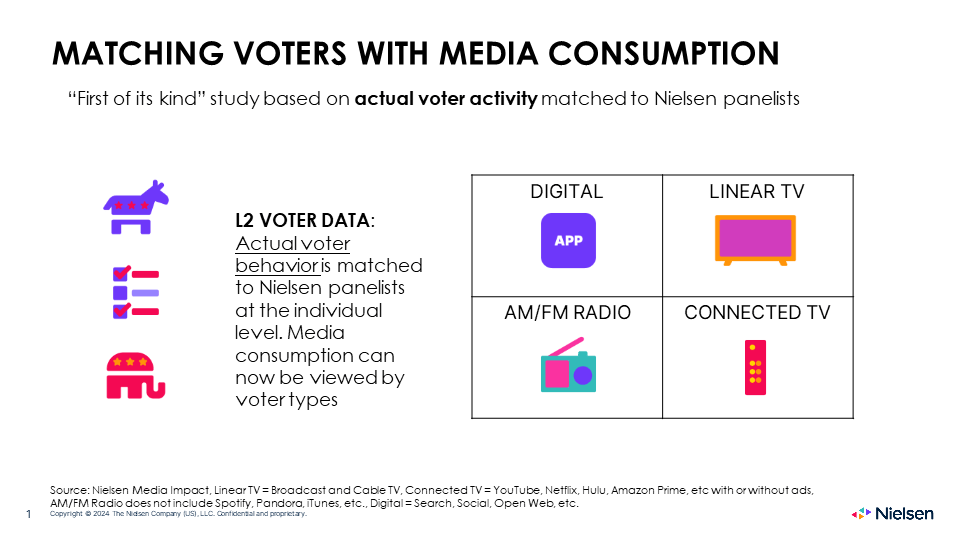
AM/FM radio has been miscast as a media strategy for small objectives
Historically, political media strategists have used AM/FM radio for limited and narrowly defined purposes: small “get out the vote” buys a few days before polls open or light buys against niche segments.
The Nielsen report indicates that AM/FM radio has significantly greater voter reach than linear TV and can be utilized as a “TV style” mass impact media.
AM/FM radio is best used as a mass voter reach platform rather than as a solver of small objectives
Nielsen reveals AM/FM radio and digital exceed TV and CTV in voter reach among all voting segments, especially with independent/unaffiliated voters.
In monthly voter reach, AM/FM radio outperforms linear TV:
- Among Republicans, 93% to 90%
- Among Democrats, 92% to 85%
- Among unaffiliated voters, 92% to 79%
One of out five unaffiliated voters are not reached by linear TV. AM/FM radio makes your TV better by supplementing and complementing linear TV, especially among independent swing voters.
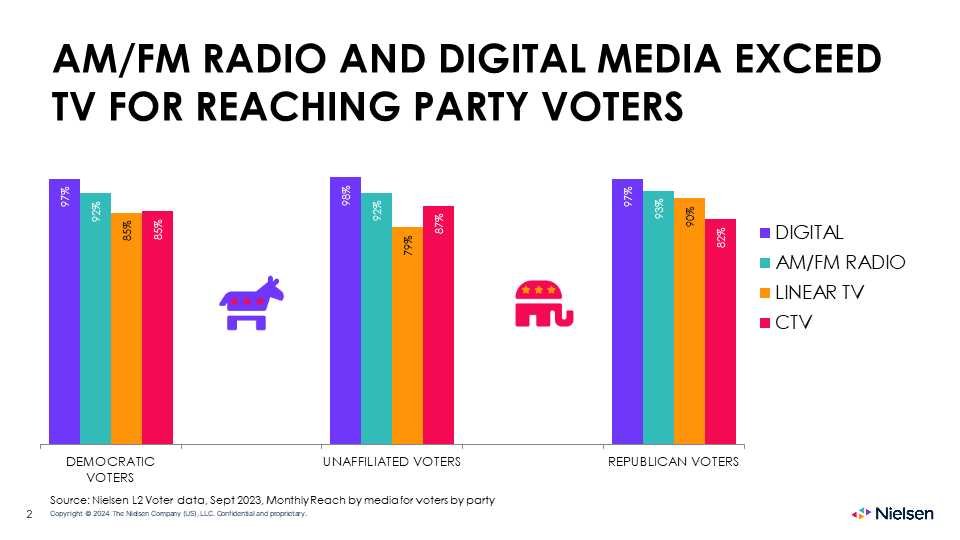
AM/FM radio can impact voters not reached by linear TV/CTV: Millennials, Gen Xers, households with children, and Hispanics
Analyzing the match of voter files to audience data, Nielsen found one of five key voter groups are not reached by linear TV: Millennials, Gen Xers, homes with children, and Hispanic households.
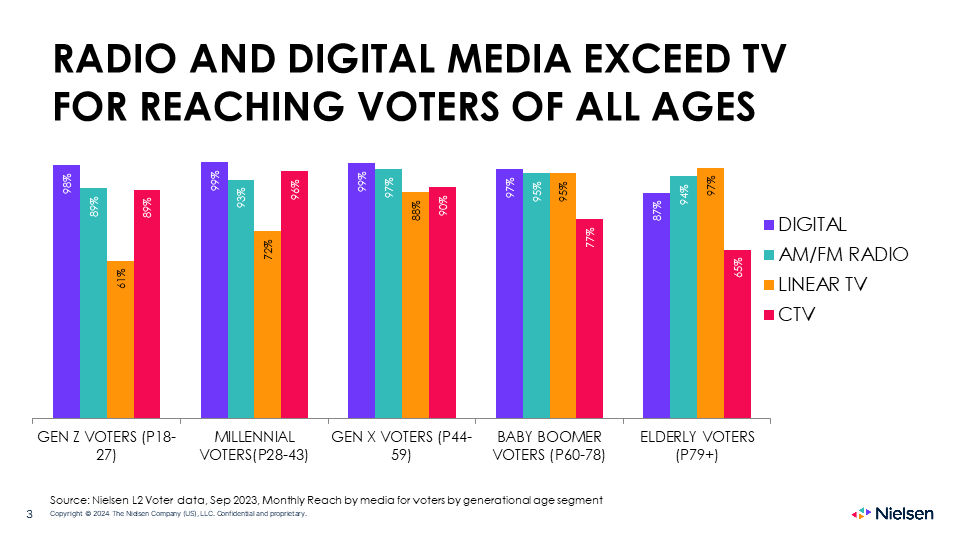
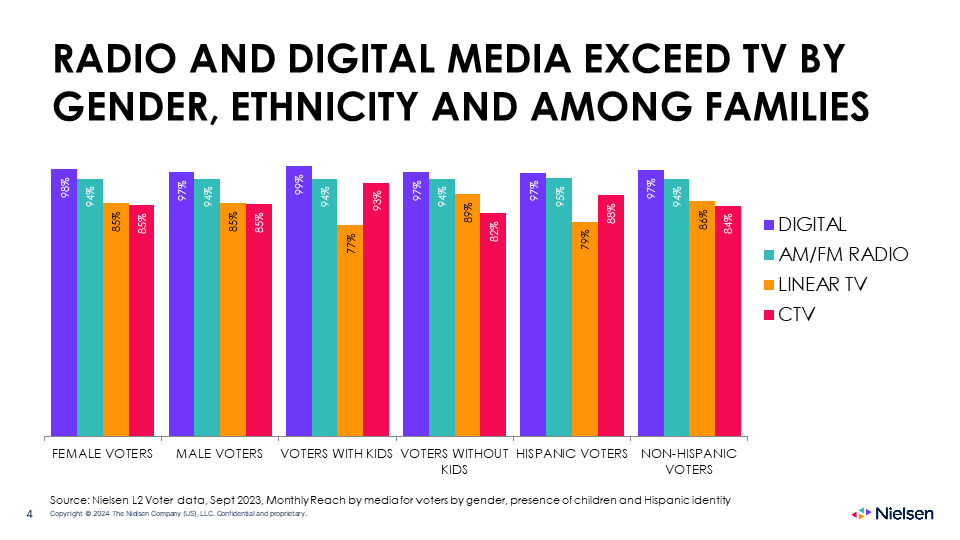
Prior political media plans lose impact: The Nielsen analysis reveals the same TV/digital/CTV buy from the prior year reaches 12% fewer voters this year.
Using Nielsen Media Impact (NMI), the media optimization platform, Nielsen examined the classic political media plan consisting of 50% of the spend on linear TV, 15% on cable, 10% on CTV, and 25% on digital. As is usually the case, AM/FM radio is not in the typical political media plan.
Nielsen found the same media plan run a year later experiences a 12% drop in voter reach.
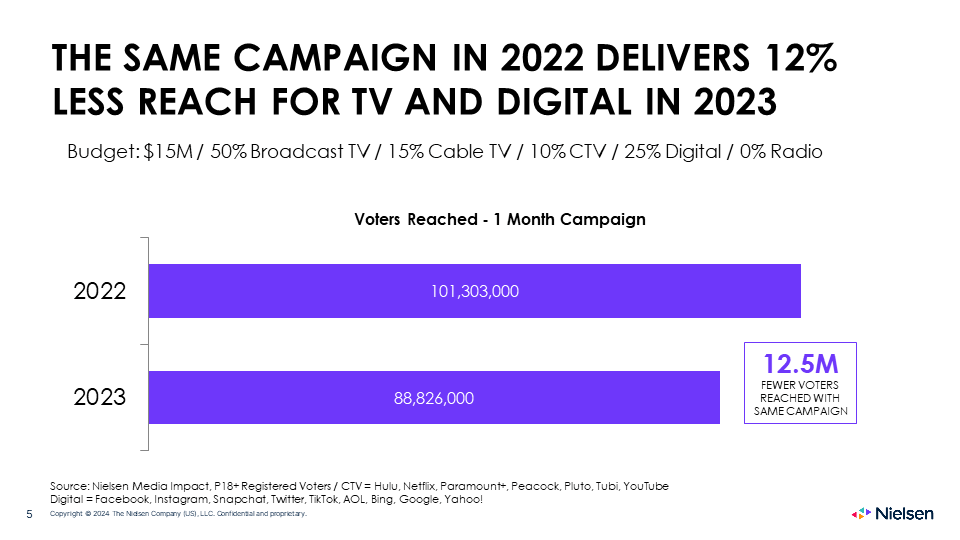
Shockingly, adding more CTV and digital does not recover TV’s lost voter reach; Nielsen found shifting large amounts to CTV/digital reduces voter reach
In media planning circles, there is a widespread belief that “CTV and digital can solve for linear TV’s collapse.” Nielsen’s analysis reveals that is not the case.
The visual below shows how varying mixes of linear TV and digital/CTV reach American voters. All the way to the left is a media plan of 100% linear TV and no CTV/digital. As you move to the right, the proportion of the plan devoted to CTV/digital grows.
At a mix of 30% digital/CTV and 70% linear TV, there is a tiny increase in voter reach (one point). The greater the amount of digital/CTV in the plan, the lower the reach. Voter reach collapses at the point where digital/CTV become the largest portion of the media plan.
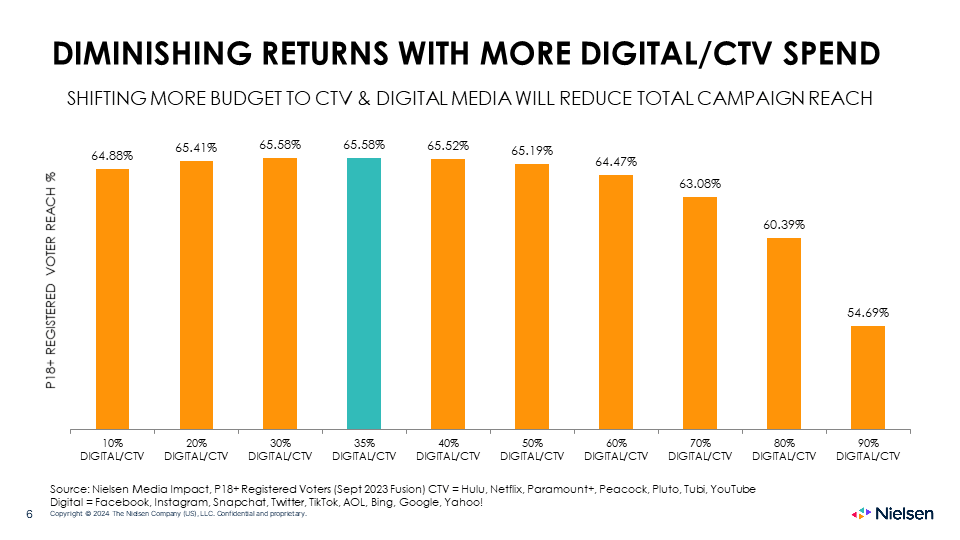
AM/FM radio to the rescue: Shifting 20% of the political media plan to AM/FM radio generates significant increases in overall voter reach, especially among undecideds, light TV viewers, Gen Xers, and Millennials. Nielsen finds allocating 20% of the media plan to AM/FM radio recovers all lost voter reach from the prior year.
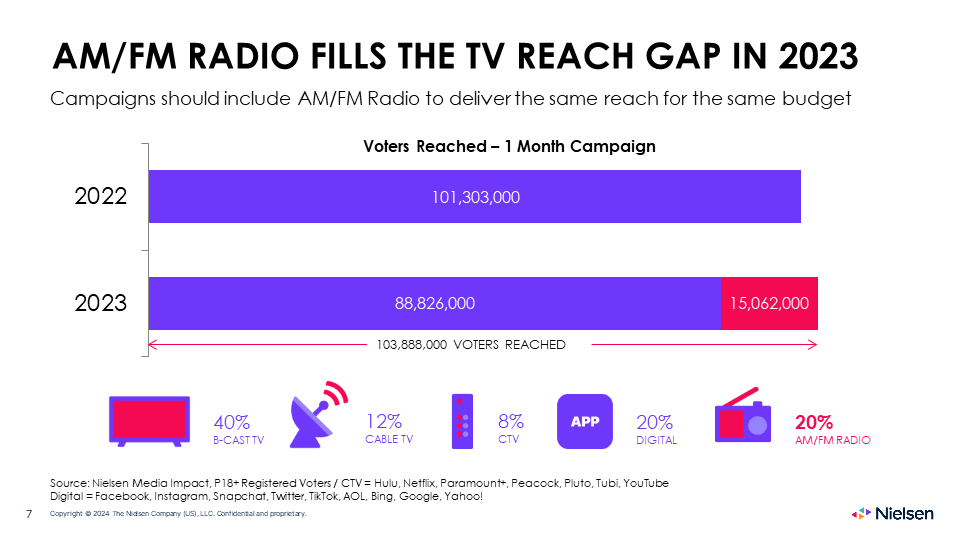
Deconstructing a political media buy: Beyond the TV base buy, AM/FM generates two-thirds of the incremental reach
Below, Nielsen pulls apart each element of a political buy to determine the incremental voter reach driven by each media platform.
- The base linear TV buy reaches 55% of voters.
- The addition of connected TV only adds 1.6% of voter reach
- The digital overlay increases voter reach by 5.6%
- Lastly, the introduction of AM/FM radio grows voter reach by an impressive 14.3%
Between CTV, digital, and AM/FM radio, two-thirds of the incremental reach is generated by AM/FM radio.
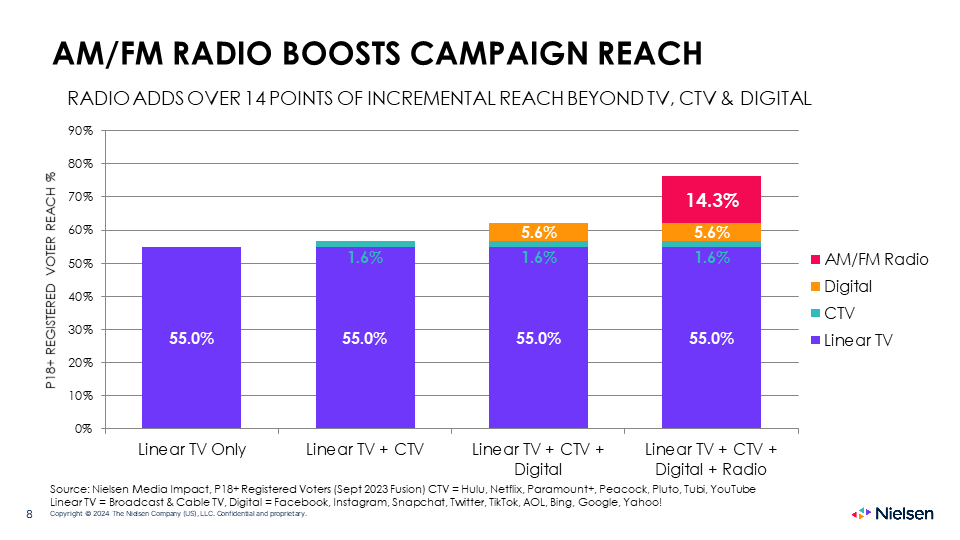
AM/FM radio generates massive reach among voters who are light TV viewers
Below, Nielsen pulls apart each element of a political buy among light TV viewers to determine the incremental voter reach driven by each media platform.
- The base linear TV buy reaches only 6.3% of voters who are light TV viewers. In other words, 94% of light TV viewers were not reached by the TV political ad buy. This is great evidence that proves out the old media planner maxim, “You cannot solve your light TV viewing problem by buying more TV!”
- The addition of connected TV only adds 3.3% of light TV voter reach.
- The digital overlay increases voter reach by 11.8% among light TV viewers.
- Lastly, introducing AM/FM radio into the media plan grows light TV viewer voter reach by an astonishing 28.9%.
Between CTV, digital, and AM/FM radio, two-thirds of the incremental voter reach among light TV viewers is generated by AM/FM radio.
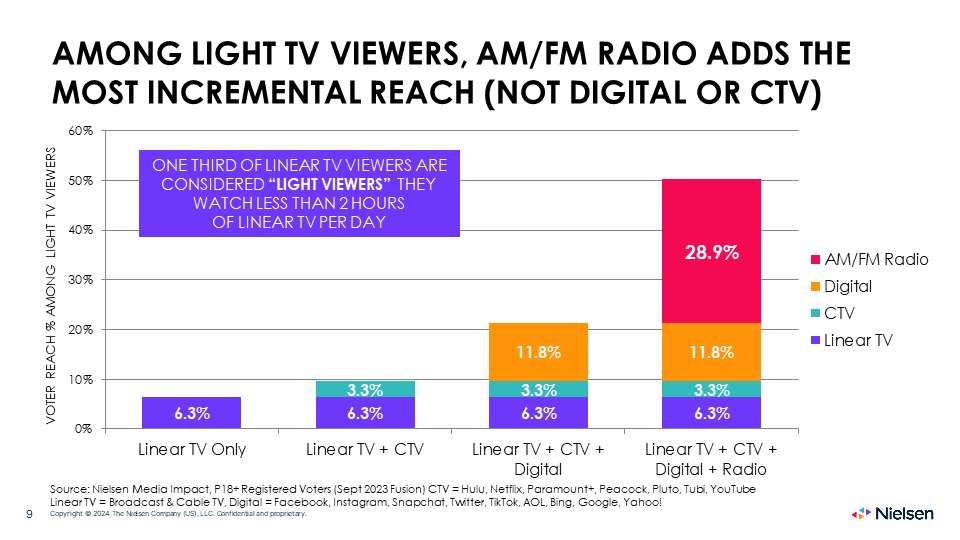
Campaigns that use AM/FM radio “early and often” benefit
The Nielsen analysis of key local races reveals early and substantial use of AM/FM radio as a mass reach platform generates impressive incremental reach in races won by narrow margins.
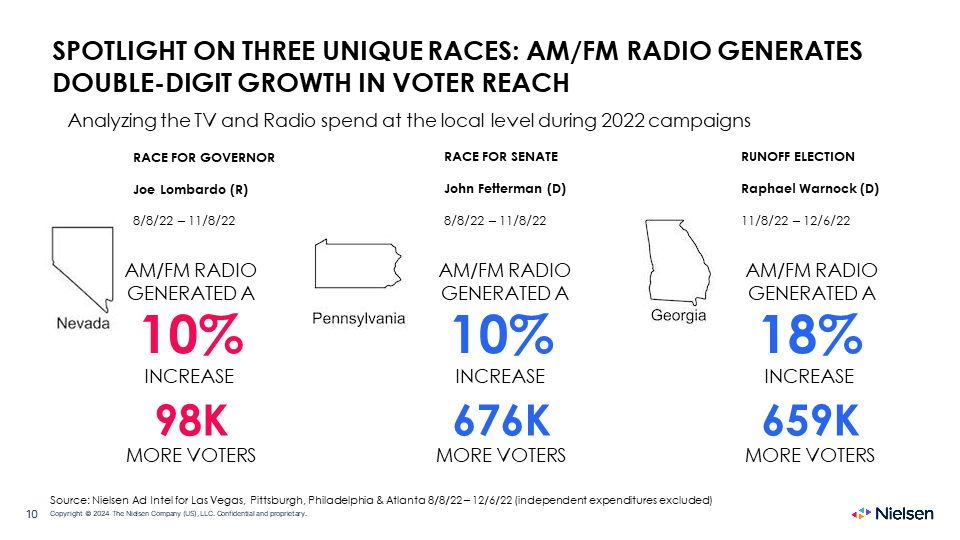
Nielsen examined the Governor’s race in Nevada and Senatorial campaigns in Pennsylvania and Georgia. In each case, the early and frequent use of AM/FM radio generated double-digit growth in incremental voter reach.
- In Nevada, AM/FM radio was directly responsible for reaching 98,000 voters not reached by TV or CTV.
- In Pennsylvania and Georgia, the addition of AM/FM radio to the media plan generated more than 600,000 new, different voters that TV or CTV could not reach.
Five key findings:
- AM/FM radio is best used as a mass voter reach platform rather than as a solution to reach tiny niches: Nielsen reveals AM/FM radio exceeds TV and CTV in voter reach among all voting segments, especially with independent/unaffiliated voters.
- Prior political media plans lose impact: The same TV/digital/CTV buy from the prior year reaches 12% fewer voters this year.
- Contrary to popular belief, CTV and digital cannot replace all of TV’s lost reach: Surprisingly, CTV and digital generate only modest voter reach lifts to the base linear TV buy.
- AM/FM radio to the rescue: Shifting 20% of the political media plan to AM/FM radio generates significant increases in voter reach overall, especially among undecideds, light TV viewers, Gen Xers, and Millennials.
- Campaigns that use AM/FM radio “early and often” benefit: The Nielsen analysis of key local races reveals early and substantial use of AM/FM radio as a mass reach platform generates impressive incremental reach in races won by narrow margins.
Click here to view a summary of the key findings from Nielsen.
Click here to view or download a PDF of the deck from Nielsen.
Click here to watch a video of the webinar.
Pierre Bouvard is Chief Insights Officer of the Cumulus Media | Westwood One Audio Active Group®.
Contact the Insights team at CorpMarketing@westwoodone.com.